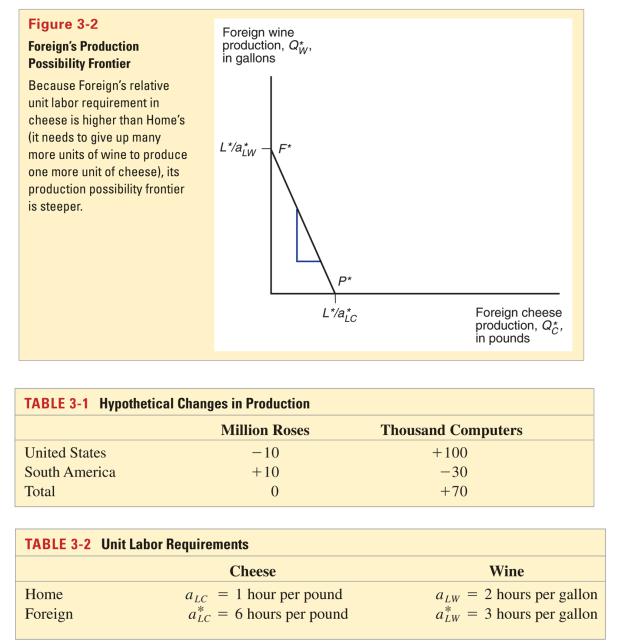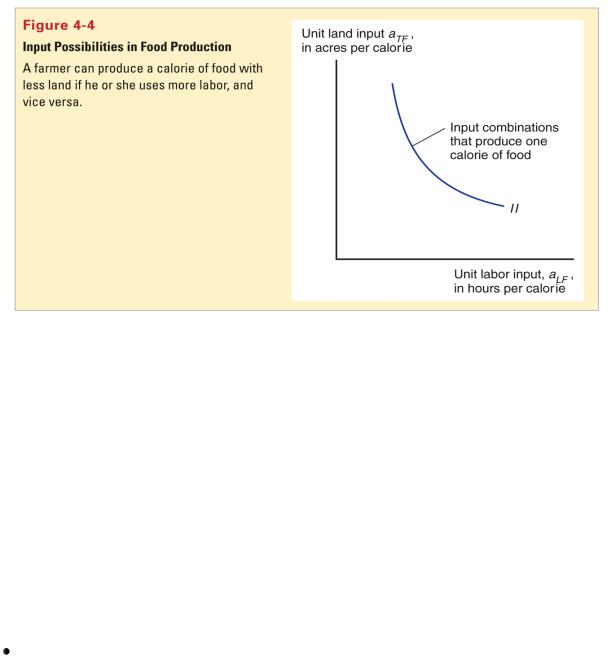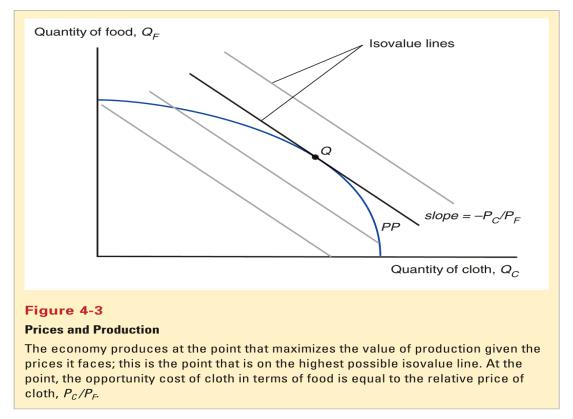
10483
.pdf
5.High productivity or low wages give countries a cost advantage that allow them to produce efficiently.
6.Although empirical evidence supports trade based on comparative advantage, transportation costs and other factors prevent complete specialization in production.
41
Chapter 4
Resources, Comparative Advantage and Income Distribution
Preview
 Production possibilities
Production possibilities
 Relationship between goods prices, factor prices and factor levels
Relationship between goods prices, factor prices and factor levels
 Relationship between goods prices, factor prices, factor levels and output levels.
Relationship between goods prices, factor prices, factor levels and output levels.
 Trade in the Heckscher-Ohlin model
Trade in the Heckscher-Ohlin model
 Factor price equalization
Factor price equalization
 Income distribution and income inequality
Income distribution and income inequality  Empirical evidence
Empirical evidence
Introduction
 While trade is partly explained by differences in labor productivity, it also can be explained by differences in resources across countries.
While trade is partly explained by differences in labor productivity, it also can be explained by differences in resources across countries.
 The Heckscher-Ohlin theory argues that international differences in labor, labor skills, physical capital or land (factors of production) create productive differences that explain why trade occurs.
The Heckscher-Ohlin theory argues that international differences in labor, labor skills, physical capital or land (factors of production) create productive differences that explain why trade occurs.
Countries have relative abundance of factors of production.
Production processes use factors of production with relative intensity.
42

Two Factor Heckscher-Ohlin Model
1.Labor and land are resources important for production.
2.The amount of labor and land varies across countries, and this variation influences productivity.
3.The supply of labor and land in each country is constant.
4.Only two goods are important for production and consumption: cloth and food.
5.Competition allows factors of production to be paid a ―competitive‖ wage, a function of their productivities and the price of the good that it produces, and allows factors to be used in the industry that pays the highest wage/rate.
6.Only two countries are modeled: domestic and foreign
Production Possibilities
 When there is more than one factor of production, the PPF (opportunity cost in production) is no longer a straight line. Why?
When there is more than one factor of production, the PPF (opportunity cost in production) is no longer a straight line. Why?
 Let’s expand the previous chapter’s model to include two factors of production, labor and land.
Let’s expand the previous chapter’s model to include two factors of production, labor and land.
aTC = hectares of land used to produce one m2 of cloth
aLC = hours of labor used to produce one m2 of cloth
aTF = hectares of land used to produce one calorie of food
aLF = hours of labor used to produce one calorie of food
L = total amount of labor available for production
T = total amount of land (terrain) available for production
Production possibilities are influenced by both land and labor (requirements):
43

 Let’s assume that each unit of cloth production uses labor intensively and each unit of food production uses land intensively:
Let’s assume that each unit of cloth production uses labor intensively and each unit of food production uses land intensively:
aLC /aTC > aLF/aTF
Or aLC /aLF > aTC /aTF
Or, we consider the total resources used in each industry and say that cloth production is labor intensive and food production is land intensive if LC /TC > LF /TF.
 This assumption influences the slope of the production possibility frontier:
This assumption influences the slope of the production possibility frontier:
 The opportunity cost of producing cloth in terms of food is not constant in this model:
The opportunity cost of producing cloth in terms of food is not constant in this model:
44

it’s low when the economy produces a low amount of cloth and a high amount of food
it’s high when the economy produces a high amount of cloth and a low amount of food
 The above PPF equations do not allow substitution of land for labor in production or vice versa.
The above PPF equations do not allow substitution of land for labor in production or vice versa.
Unit factor requirements are constant along each line segment of the PPF.
 If we allow substitution of inputs, then the PPF becomes curved.
If we allow substitution of inputs, then the PPF becomes curved.
For example, many laborers could work on a small plot of land or a few labors could work on a large plot of land to produce the same amount of output.
Unit factor requirements are not constant at every quantity of cloth and food produced.
45

Input Possibilities
Production and Prices
 The production possibility frontier describes what an economy can produce, but to determine what the economy does produce, we must determine the prices of goods.
The production possibility frontier describes what an economy can produce, but to determine what the economy does produce, we must determine the prices of goods.
 In general, the economy should produce at the point that maximizes the value of production, V:
In general, the economy should produce at the point that maximizes the value of production, V:
V= PCQC + PFQF
where PC is the price of cloth and PF is the price of food.
Define an isovalue line as a line representing a constant value of
production.
V = PCQC + PFQF
PFQF = V – PCQC
QF = V/PF – (PC /PF)QC
The slope of an isovalue line is – (PC /PF)
46

 Given prices of output, one isovalue line represents the maximum value of production, say at a point Q.
Given prices of output, one isovalue line represents the maximum value of production, say at a point Q.
 At that point, the slope of the PPF equal – (PC /PF), so the opportunity cost of cloth equals the relative price of cloth.
At that point, the slope of the PPF equal – (PC /PF), so the opportunity cost of cloth equals the relative price of cloth.
Factor Prices, Goods Prices and Factor Levels
 Producers may choose different amounts of factors of production used to make cloth or food.
Producers may choose different amounts of factors of production used to make cloth or food.
 Their choice depends on the wage rate, w, and the (opportunity) cost of using land, the rental rate r.
Their choice depends on the wage rate, w, and the (opportunity) cost of using land, the rental rate r.
 As the wage rate increases relative to the rental rate, producers are willing to use more land and less labor in the production of food and cloth.
As the wage rate increases relative to the rental rate, producers are willing to use more land and less labor in the production of food and cloth.
47

Recall that food production is land intensive and cloth production is labor intensive.
 Under competition, the price of a good equals the cost of production, and the cost of production depends on the wage rate and the rental rate.
Under competition, the price of a good equals the cost of production, and the cost of production depends on the wage rate and the rental rate.  The effect of the rental rate of land on the price of cloth depends on the intensity of land usage in cloth production.
The effect of the rental rate of land on the price of cloth depends on the intensity of land usage in cloth production.
An increase in the rental rate of land will affect the price of food more than the price of cloth.
 Under competition, changes in w/r are therefore directly related to changes in PC /PW .
Under competition, changes in w/r are therefore directly related to changes in PC /PW .
48

 We have a relationship among factor prices and good prices and the levels of factors used in production:
We have a relationship among factor prices and good prices and the levels of factors used in production:
 Stolper-Samuelson theorem: if the relative price of a good increases, then the real wage or rate of return of the factor used intensively in the production of that good increases, while the real wage or rate of return of the other factor decreases.
Stolper-Samuelson theorem: if the relative price of a good increases, then the real wage or rate of return of the factor used intensively in the production of that good increases, while the real wage or rate of return of the other factor decreases.
Under competition, the real wage/return is equal to the marginal productivity of the factor.
Marginal productivity of a factor increases as the level of that factor used in production decreases.
 We have a theory that predicts changes in the distribution of income when the relative price of goods changes, say because of trade.
We have a theory that predicts changes in the distribution of income when the relative price of goods changes, say because of trade.
49

 An increase in the relative price of cloth, PC /PF , will:
An increase in the relative price of cloth, PC /PF , will:
raise income of workers relative to that of landowners, w/r.
raise the ratio of land to labor, T/L, in both industries and raise the marginal product of labor in both industries and lower the marginal product of land in both industries.
raise the real income of workers and lower the real income of land owners.
Factor Prices, Goods Prices,
Factor Levels and Output Levels
 The allocation of factors used in production determine the level of output at the economy’s PPF.
The allocation of factors used in production determine the level of output at the economy’s PPF.
 We summarize the relationship between the levels of factors used in production and output levels, using the following diagram:
We summarize the relationship between the levels of factors used in production and output levels, using the following diagram:
50
